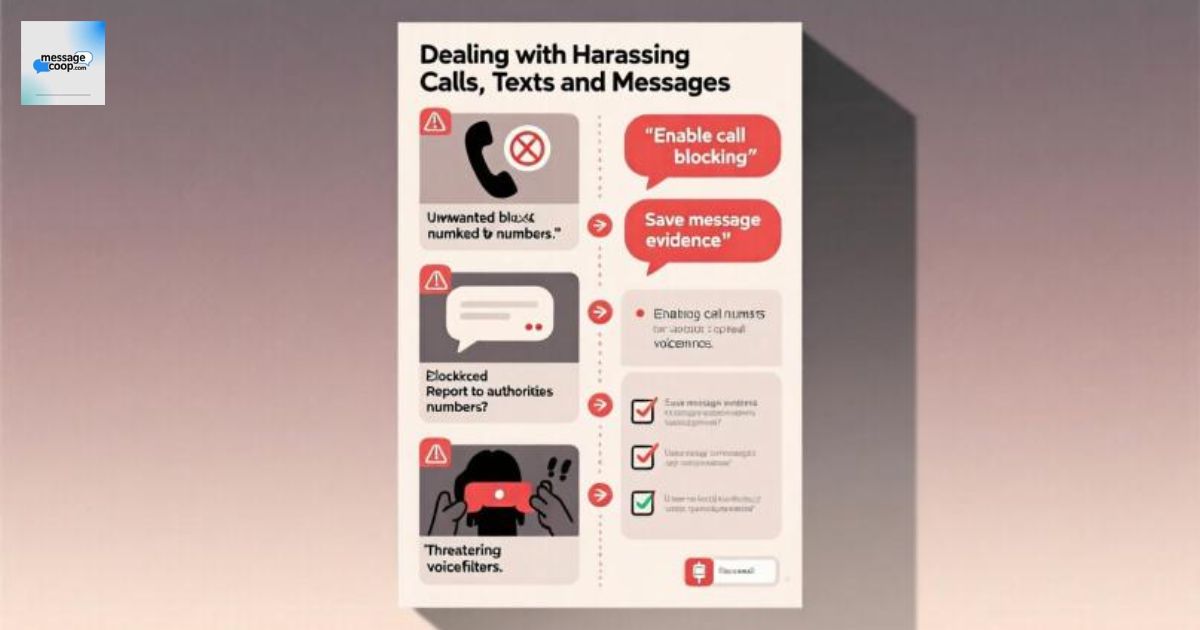Dealing with harassing calls, texts, and messages can be overwhelming and emotionally draining. These unwanted contacts ,whether through phone harassment, cyber harassment, or online harassment ,can disrupt your daily life and create constant anxiety. From stalking and threatening messages to persistent spam calls and social media harassment, the impact can be both mentally and emotionally exhausting. Many victims of harassing calls, texts, and messages feel trapped, unsure how to block, document, or report the abuse.
If you are experiencing harassing calls, texts, and messages, it’s important to know you have options. Whether it’s blocking abusive numbers, reporting harassment to service providers, seeking legal remedies, or improving your privacy settings, there are clear steps to protect yourself. Understanding how to document harassment, manage caller ID blocking, and safeguard your online presence can help you reclaim peace of mind and stop harassing calls, texts, and messages from controlling your life.
Dealing with Harassing Calls, Texts, and Messages: Practical Steps, Legal Paths & Digital Safety
Harassment through phone calls, SMS, and messaging apps can feel relentless. It shows up at inconvenient hours, follows you across platforms, and chips away at your sense of safety. The good news: you have options. Whether your priority is to stop the contact, preserve evidence, strengthen privacy settings, or pursue legal action, the roadmap below lays out concrete steps you can take,at your pace and on your terms.
Important: This guide offers general information, not legal advice. Laws and procedures vary by location. If you’re in immediate danger, contact emergency services.
Your Options at a Glance
- Immediate relief: Block, mute, filter, and adjust device settings to reduce exposure right now.
- Evidence building: Save screenshots, logs, voicemails, and profile links to support any future action.
- Platform reports: Use in-app tools to report abuse and request content removal or account actions.
- Phone carrier help: Ask about number blocking, spam controls, and call-forwarding features.
- Legal pathways: Explore protective orders and criminal complaints where applicable.
- Well-being: Choose strategies that minimize harm and avoid re-traumatization.
Legal Pathways & When to Involve Authorities
If the behavior includes threats, stalking, or persistent unwanted contact, law enforcement may be an option. Depending on your jurisdiction, remedies can include:
- Protective/Restraining Orders: Civil court orders that can restrict contact, proximity, or communication.
- Criminal Complaints: For offenses such as stalking, criminal harassment, threats, or unlawful publication of private information.
- Bail/Release Conditions (if applicable): If the person has been charged, the court may impose rules limiting contact.
How to prepare before speaking with police or a lawyer

- Bring a timeline of incidents (dates, times, platforms, phone numbers).
- Provide evidence samples (screenshots, call logs, voicemails, URLs, user IDs).
- Note witnesses (if anyone saw messages or observed related behavior).
- State your goal (e.g., stop contact, document for now, or pursue charges).
If you’re unsure which route fits your situation, consider a brief consultation with a legal aid organization or an anti-violence advocate familiar with local processes.
Documenting Harassment Without Burning Out
Documentation can empower you,but it can also be emotionally draining. Choose a method that feels sustainable:
- Create a simple log: Date, time, platform/number, summary (“3 missed calls after midnight,” “message containing threat”).
- Save raw evidence: Screenshots with visible usernames, timestamps, and URLs; export chat histories when possible.
- Preserve audio: Save voicemails and call recordings where legally allowed.
- Back up securely: Store copies in a cloud folder or encrypted drive; avoid sharing from your primary device if that increases risk.
- Use file names that sort well: YYYY-MM-DD_platform_username_topic.ext.
Tip: If logging is triggering, consider batching (review once per week), asking a trusted person to help, or using a dedicated “evidence phone” or email to receive forwarded items.
Reporting Abuse to Companies & Platforms
Most services prohibit harassment in their terms. Reporting helps create a record and may lead to enforcement:
Phone/Wireless Providers
- Ask about network-level blocking, spam filters, and call-trace options.
- Confirm whether your identity is revealed to the other party during an investigation. If anonymity is important to you, weigh this before proceeding.
Social Media & Messaging Apps
- Use in-app reporting for harassment, impersonation, doxxing, or threats.
- Capture evidence first (screenshots, profile links) in case content is removed.
- After reporting, consider blocking or muting to limit exposure.
- Track ticket numbers or confirmation emails for your records.
Smart Ways to Limit Contact (Without Losing Your Whole Digital Life)
Total disconnection isn’t your only option. Mix and match the strategies below based on your needs.
1) Block, Mute, Filter
- Block known numbers/accounts to prevent calls or messages from landing.
- Mute or filter messages so they go to a hidden or “requests” folder.
- Focus/Do Not Disturb modes can allow only selected contacts to reach you.
Limitation: Blocking one number or account won’t stop the person from using another. Consider layered defenses.
2) Custom Alerts That Reduce Anxiety
- Assign a distinct ringtone or silent alert to the harasser’s number.
- Keep normal tones for everyone else so you’re not on edge all day.
3) Let It Roll to Voicemail
- Send suspicious calls directly to voicemail to avoid engagement while preserving evidence.
- Periodically export voicemails and store them in your evidence folder.
4) Second Line or Second Phone
- Use a separate number (app-based or SIM) for essential communications (co-parenting, pets, logistics).
- Keep your primary number private for trusted contacts only.
5) Targeted Call Forwarding
- Some carriers let you forward a specific caller to another number or to voicemail.
- This can keep your main phone quiet while evidence still accumulates elsewhere.
6) New Number or Fresh Accounts (If Cutting Ties)
- If you change numbers or handles, pair it with tight privacy settings and limited sharing.
- Tell trusted contacts not to post or share your new details.
- Update important services (banks, schools, health providers) via secure channels.
7) Hide Your Caller ID (When You Must Call)
- Use caller ID blocking in settings or carrier codes to mask your number on a per-call basis (availability varies by provider).
- Consider a virtual number to place necessary calls without exposing your primary line.
Privacy & Security Tune-Up (Highly Recommended)

A quick hygiene pass can shrink attack surfaces and reduce info leaks:
- Audit privacy settings on social and messaging apps; limit who can find you by phone or email.
- Lock down friend lists and hide your contact details from public view.
- Review app permissions on your phone (microphone, contacts, location).
- Enable two-factor authentication (2FA) on email and social accounts.
- Change passwords for any accounts the person might know or guess; use a password manager.
- Check account recovery options (backup email/phone) to ensure only you can reset passwords.
- Scan for linked devices/sessions and sign out everywhere you don’t recognize.
When You Need to Keep Limited Contact
Sometimes zero contact isn’t realistic (co-parenting, shared property, workplace needs). If you must keep a channel open:
- Choose a single medium for communication (e.g., email only) to simplify evidence collection.
- Use brief, factual responses; avoid emotional back-and-forth.
- Template replies help you stay consistent (“Please restrict messages to child pickup times. Other topics will not be addressed.”).
- Time-box when you check that channel (e.g., 10 minutes at 6pm) to protect your peace.
Emotional Safety Matters
Harassment is exhausting. Protect your mental health as much as your devices:
- Lean on trusted friends, family, or support lines for debriefing.
- Consider counseling or a support group experienced in digital abuse.
- If reviewing evidence is triggering, ask someone you trust to help organize it.
- Celebrate small wins,each boundary you set is progress.
What to Save (Quick Evidence Checklist)
- Screenshots of messages (with usernames, timestamps, and URLs visible)
- Call logs and missed call screenshots
- Voicemails and audio files (exported if possible)
- Profile links/user IDs of the sender
- Ticket numbers from platform or carrier reports
- A dated incident log summarizing each contact
If You’re Not Ready to Report,That’s Okay
You can still:
- Harden your privacy settings,
- Limit exposure with blocking/muting,
- Quietly build an evidence set, and
- Talk to an advocate about options,now or later.
FAQ,s
What is harassing phone calls and texts?
These unwanted contacts can include threats, repeated calls, or offensive messages. Many people facing harassing calls, texts, and messages feel unsafe and need support.
What to do about harassing texts?
Save all evidence, block the sender, and report it to the platform or carrier. Taking action against harassing calls, texts, and messages can help stop the abuse.
What is an example of a harassing message?
A message containing threats, insults, or repeated unwanted contact can be harassment. Harassing calls, texts, and messages often aim to intimidate or emotionally harm the recipient.
What do you do about harassing phone calls?
Avoid answering unknown numbers, let calls go to voicemail, and keep records. Reporting harassing calls, texts, and messages can lead to action from authorities or service providers.
How do you stop someone from harassing you?
Block the number, adjust privacy settings, and limit contact. Seek help if harassing calls, texts, and messages persist despite taking these protective measures.
Also Read: Celebration of Life Invitation Wording for a Heartfelt Message
Conclusion
Dealing with harassing calls, texts, and messages can be stressful and upsetting. They can interrupt your day, harm your peace of mind, and make you feel unsafe. It is important to know that you have options. You can block numbers, adjust privacy settings, and report abuse to stop harassing calls, texts, and messages. You can also document harassment for evidence and seek legal help if needed. Taking action helps you feel more in control.
No one should have to live with harassing calls, texts, and messages. Protecting your privacy and safety is your right. Use social media blocking tools, caller ID blocking, and support from your phone service provider to manage these issues. If harassing calls, texts, and messages continue, reach out to trusted contacts or authorities. Every step you take makes a difference. You deserve to feel safe both online and offline.

